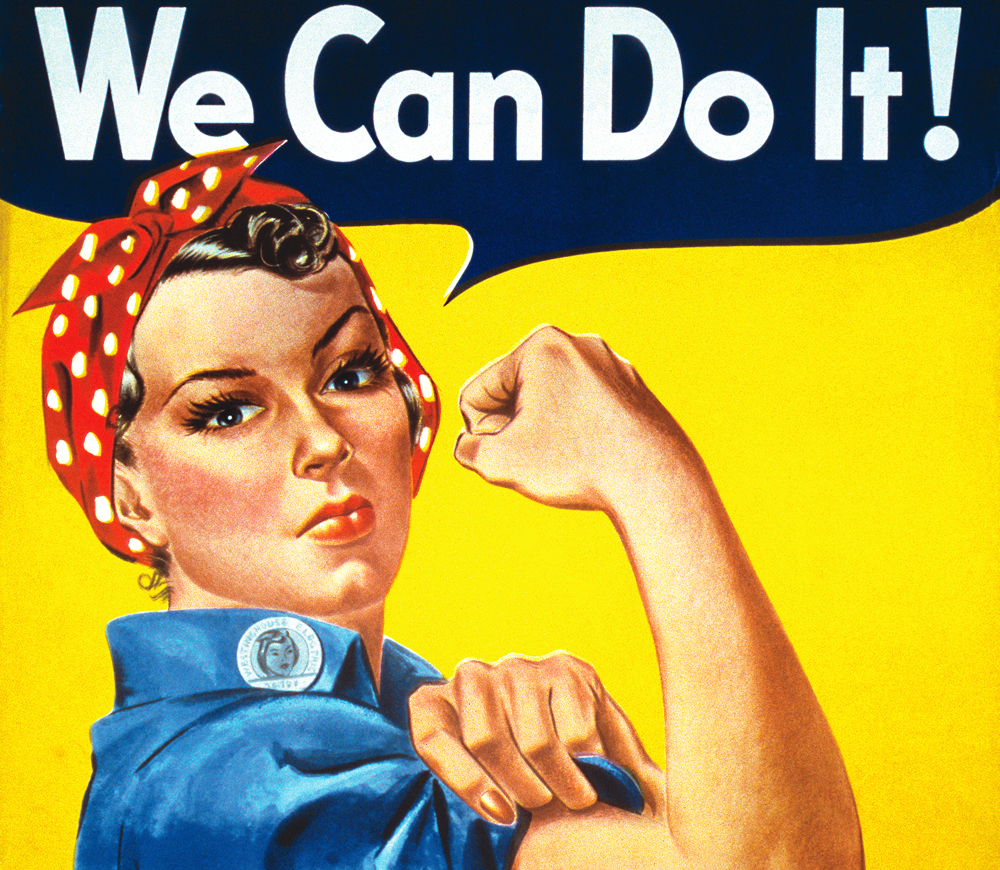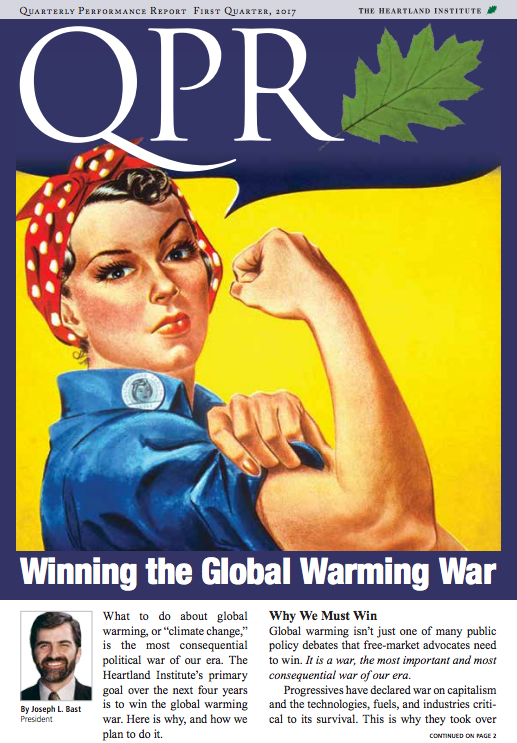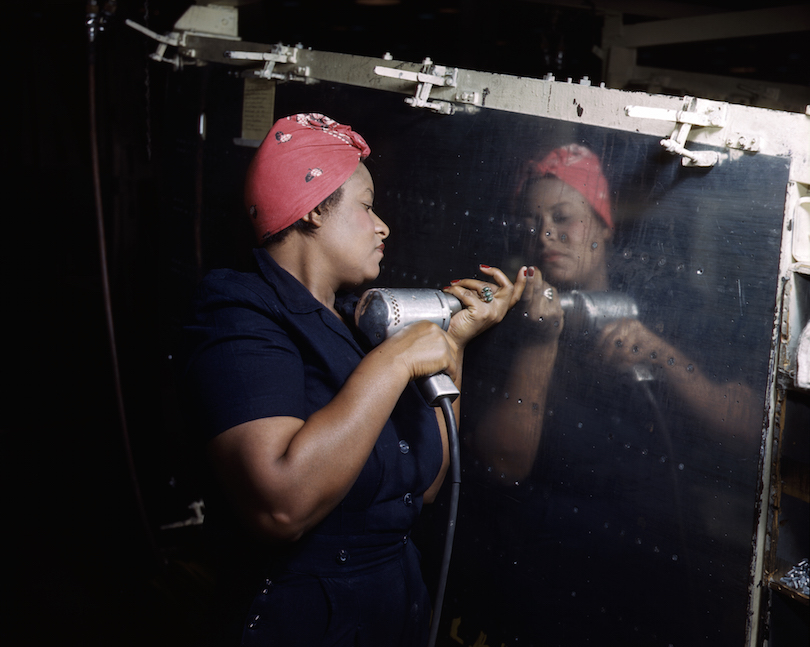Her image is iconic — red polka dot bandanna around her hair, blue sleeve rolled back, exposed bicep curled in a show of strength, a speech bubble declaring, “We Can Do It!”
We know her today as “Rosie the Riveter,” and she’s shown up on t-shirts, coffee cups, oven mitts, bobble-head dolls, and now, even a quarterly report of the fossil fuel industry–funded think tank, the Heartland Institute.
In its report, the Heartland Institute — infamous for its offensive 2012 billboard depicting the Unabomber as a “believer” in global warming — displays the image of Rosie over the slogan “Winning the Global Warming War.” It sits atop an article by Joseph L. Bast, Heartland’s president, issuing a call to arms for “free-market advocates” against global warming. While Bast’s litany of commonly debunked arguments against the science and threat of climate change isn’t notable, Heartland’s choice of imagery is proving to be.
“To me, it seems like an obscene appropriation of feminist iconography, and I find it, frankly, offensive,” Sarah Myhre, University of Washington ocean and climate scientist, told DeSmog. “And I looked for a mention of women or women’s lives and there’s no mention of women in the article whatsoever.”
Where’s a Single Lady?
Bast’s article fails to make a single connection to women among his claims of “fake science” and the scientific community being “deeply divided and unsure over the causes and consequences of climate change.” (Climate scientists overwhelmingly agree humans are the primary cause and that its impacts are and will be significant enough to justify taking action.)
“Those are the classic tropes that are used to inflame skepticism around the science that underlies climate change, so as to not have to look directly at the very difficult and challenging nature of economic change that is necessary to respond to the science,” said Myhre. “I feel like I’ve read this little blurb a thousand times in other places.”
The Heartland Institute’s report uses Rosie the Riveter’s image in a call to arms against renewable energy and action on climate change.
Bast instead points to what he calls a “pro-environment” agenda appearing later in the report, which states, “We owe it to future generations to leave the world a better place than we found it.” It goes on to bash renewable energy as being more harmful to the environment than fossil fuels.
The United Nations, however, considers women to be “more vulnerable to the effects of climate change than men — primarily as they constitute the majority of the world’s poor and are more dependent for their livelihood on natural resources that are threatened by climate change.”
Yet Bast calls the conservative effort to block action on climate change “the most important and most consequential war of our era,” and declares that “The Heartland Institute’s primary goal over the next four years is to win the global warming war.” He also hints at plans to crowdsource ideas for replacing the U.S. Environmental Protection Agency (EPA), a favorite target by Congressional Republicans.
Rosie appears again in Bast’s appeal for money to help Heartland in “educating policymakers and the public on why we must win the global warming war.”
Considering how Rosie the Riveter made numerous appearances associated with the Women’s March earlier this year (which included support for science and the EPA), this juxtaposition makes Heartland’s use of the image in its report all the more poignant.
Myhre wondered about the organization’s use of the symbol, asking, “Is the Heartland Institute recognizing a sign of the times and how women’s voices are not going to go away?”
One woman’s sign calls to “Save the EPA” during a rally before the Women’s March on Washington the day after Trump’s inauguration. © 2017 Julie Dermansky
“The legendary Rosie the Riveter”
President Donald Trump also invoked Rosie’s name Wednesday in a speech to car companies and suppliers at Willow Run, a former manufacturing facility not far from Detroit, Michigan, which at one point built planes during World War II.
“Great Americans of all backgrounds built the arsenal of democracy, including the legendary Rosie the Riveter who worked here at Willow Run,” said Trump.
Now, there was in fact a woman named Rose Will Monroe who worked as a riveter at Michigan’s Willow Run plant during World War II, and purportedly was nicknamed “Rosie the Riveter.”
But there wasn’t just one Rosie (real or symbolic). Female riveters named Rose or Rosalind were not uncommonly called this at the time thanks to a song unassociated with the popular image we’re familiar with now.
Who Really Was Rosie?
In reality, that image we today know as Rosie likely inspired few female workers during World War II.
“We really don’t think it would have been empowering or feminist at all in the original context,” James Kimble, propaganda expert and associate professor at Seton Hall University, told DeSmog. “Really it was kind of the opposite.”
The image we call “Rosie the Riveter” — the woman worker declaring “We Can Do It!” — first appeared on a company propaganda poster created by artist J. Howard Miller. It was part of a series of more than 40 posters which hung in Westinghouse munitions plants during World War II.
“Not a single one of the other ones could you describe as being remotely feminist,” said Kimble of the rest of the Westinghouse propaganda posters.
What we today consider “Rosie’s” poster only appeared for a brief two-week window in February 1943.
“We argue that for this brief moment, maybe there was this kind of empowerment, but it was washed out by all these other images of masculine war and factory and homemakers waving goodbye to their breadmakers as they go off to work,” said Kimble, referring to findings from a 2006 scholarly article on Rosie the Riveter by him and colleague Lester Olson.
One of the many women working as part of the war effort in World War II, shown here operating a hand drill at Vultee-Nashville, Tennessee, on an A-31 Vengeance dive bomber in February 1943. Credit: Alfred T. Palmer, U.S. Office of War Information, public domain
At the time, the poster of Rosie actually had motivations behind it that would today be considered very un-progressive.
“It was used by the corporation, by Westinghouse, to control workers,” said Kimble. “That’s what their posters did. They were aimed at reducing the potential for strikes, cut down on absenteeism. So, very different I think than what we think of it today.”
Yet Rosie the Riveter has been transformed over time into a popular and effective symbol for women’s rights and empowerment in the modern era. “It’s done a complete 180 turn,” Kimble said, with women claiming the symbol in a way similar to the gay community turning the term “queen” from an epithet into an expression of pride.
But would Rosie the Riveter go to war against climate change science, as Heartland’s report might suggest? In the U.S., women tend to be more concerned about climate issues than men, according to a 2016 Pew report. In addition, the report notes that “those most concerned about climate issues come from all gender, age, education, race and ethnic groups.”
So, probably not.
Main image: A cropped version of J. Howard Miller’s now-famous propaganda poster for Westinghouse Corporation’s munitions plants, which has become known as “Rosie the Riveter.” Credit: J. Howard Miller, public domain
Subscribe to our newsletter
Stay up to date with DeSmog news and alerts










